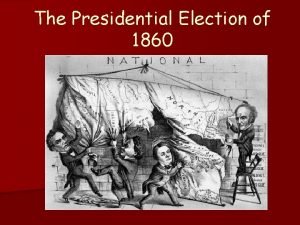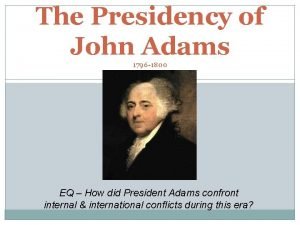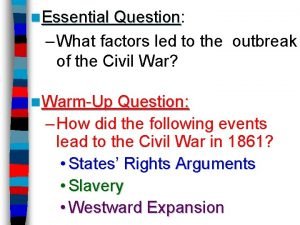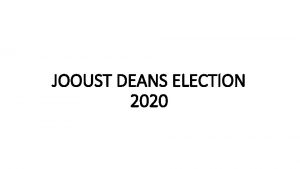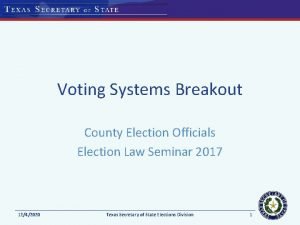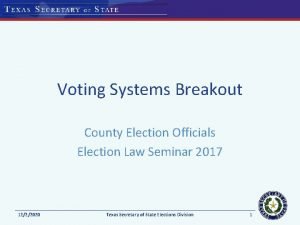Voting Methods Election TheorySocial Choice Theory Class Voting














- Slides: 14

Voting Methods Election Theory—Social Choice Theory

Class Voting Activity • List the following, in order, on your “ballot”: • Coke • Dr. Pepper • Mountain Dew • Pepsi • Sprite Now rank them 1 -5, with 1 as your number one pick. Place your ranking number next to each soft drink name. Turn in your paper

Preference Table • Copy the class data from the board. We will now create a preference table of the data. Number of votes: Coke Dr. Pepper Mountain Dew Pepsi Sprite

Your Group Mission: Devise a method of combining the rankings of all the individuals in your class into a single class ranking. Your method should produce a 1 st, 2 nd, 3 rd, 4 th, and 5 th place soft drink for the entire class. You will present your ranking to the class and describe the method used toas obtain Address these questions you workit. in your group on this mission: 1. Did all the group rankings produced in your class have the same soft drink ranked 1 st? If not, which soft drink was ranked first most often? 2. Repeat Exercise 1 for the soft drink ranked second. 3. Repeat Exercise 1 for the soft drink ranked third. 4. Repeat Exercise 1 for the soft drink ranked fourth. 5. Repeat Exercise 1 for the soft drink ranked fifth. 6. Write a description of the method you used to achieve a group ranking. Make it clear enough that someone else could use the method. You may want to break down the method into numbered steps. 7. Did your method result in any ties? How could you modify your method to break a tie?

Exit Ticket: When your class members voted, they ranked the soft drinks from 1 st-5 th. However, voters in most U. S. elections do not get to rank the candidates. Do you think allowing voters to vote by ranking candidates would be a good practice? Explain. Point of Interest 1996 Presidential Election Results Candidate Popular Vote Electoral College Vote Bill Clinton 47, 402, 357 279 Bob Dole 39, 198, 755 159 Ross Perot 8, 085, 402 0 Others 1, 591, 120 0 Although presidential elections in the U. S are decided in the electoral college, it is rare for the winner of the popular vote to lose in the electoral college.


Majority Rule •

Plurality Method • Each voter votes for one candidate. The candidate with the most votes is the winner. • Isn’t this a majority? ? . . .

Borda Count • Each voter ranks the n candidates with n points assigned to the first choice, n – 1 to the second choice and so on. The candidate with the most points wins. • Heisman Trophy uses Borda Count. Baseball MVP uses modified Borda Count with a 1 st place vote worth 14, 2 nd place 9, 3 rd place 8… 10 th place 1.

Hare Method…or Plurality with Elimination • If there is no majority winner, then the candidate with the fewest number of first place votes is eliminated. The election is held again and if no majority winner is found, the candidate with the fewest first place votes is eliminated and the election is held again. Repeat until a majority winner is found.

Pairwise Comparison Method • Each voter ranks the candidates. Each candidate is compared to each of the other candidates and the candidate who is preferred gets one point. The candidate with the most points wins.

Approval Method • Each voter votes for all the candidates they approve of. The candidate with the most votes wins.

Tournament Method • Compare the entire slate of candidates two at a time, in a pre-determined order. The candidate with the fewest votes is eliminated and the winner goes on to compare with the third candidate. These pairwise comparisons continue until a winner is found.

Fairness Criteria…Tie Breakers… • Majority: If a candidate receives a majority of the first place votes, then that candidate should be declared the winner. • Condorcet: If a candidate is favored when compared one-to-one with every other candidate, then that candidate should be declared the winner. • Monotonicity: A candidate who wins a first election and then gains additional support without losing any of the original support, should also win a second election. • Irrelevant Alternatives: If a candidate is declared the winner of an election, and in a second election one or more of the candidates is removed, then the previous winner should still be declared the winner. • Note that there may be a tie—the method to bread a tie should be in place before the election!
 What are the four common methods of voting in ffa
What are the four common methods of voting in ffa Good choice or bad choice
Good choice or bad choice Inlay wax pattern fabrication
Inlay wax pattern fabrication Class choice
Class choice Food choice test class
Food choice test class Welcome to hillcrest high
Welcome to hillcrest high Cobra election form sample
Cobra election form sample Brainpop political parties
Brainpop political parties Party platform definition
Party platform definition What problems did this election underscore
What problems did this election underscore The election of 1800 showed that
The election of 1800 showed that Lincolns election date
Lincolns election date Abraham lincoln's election
Abraham lincoln's election Lincolns election
Lincolns election British election study
British election study








